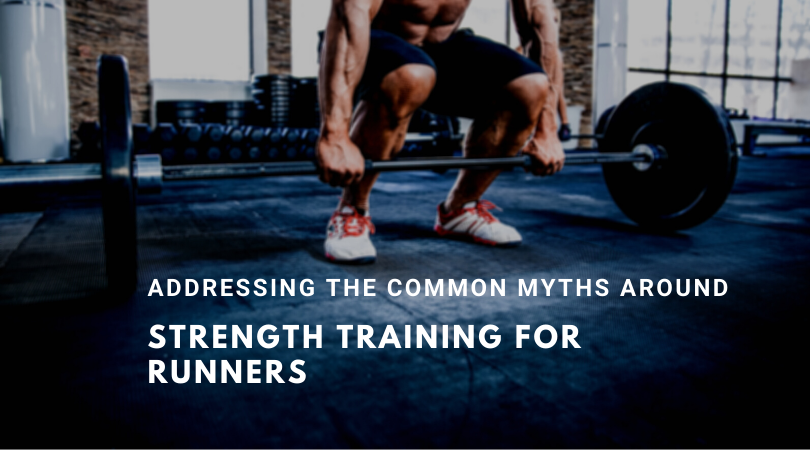Common Strength Training Myths for Runners

There are certainly common gym myths floating around the running community. My guess is because most runners don’t like strength training. Any excuse will do, right? The myths I will be talking about stems from the work by Richard Blagrove. Rich is a brilliant researcher and is world renowned for strength training and running performance. His book titled: Strength & Conditioning for Endurance Running is insightful and highly recommended. I had the pleasure of interviewing Rich on my podcast The Run Smarter Podcast & you can listen here.
Strength training for runners
Myth #1: Lifting weights will make me put on too much muscle
You might reason that an increase in body weight is detrimental for endurance running. After all, more energy is required to move a larger mass. But will you put on weight if you start lifting weights? Allow me to add a few comments to this topic:
Firstly, there are different ways to lift weights, and a runner shouldn’t be training for hypertrophy (bigger muscles). In fact, it takes an extremely dedicated gym go-er training at high volumes with a high protein diet to match, in order to gain muscle mass. The volumes and frequencies a runner requires for performance simply is not the same. Richard Blagrove describes the ‘Interference effect’. When strength and endurance training are programmed concurrently, the body will prioritise endurance performance. In other words, you will make strength gains without increasing muscle mass. Lastly, and importantly, gym goers work so hard to put on muscle! You will not stroll into a gym for the first time and see these gains. It’s similar to a gym goer deciding not to run because they don’t want to be a sub 3h marathon runner!

Myth #2: Weight training causes injury
With the correct technique achieved, and keeping in mind your training loads are not too excessive, the risk of injury is negligible. With past research establishing the ‘relative risk’, weight training encounters 2-4 injuries every 10,000 hours while cross-country runners accumulate 37 injuries per 10,000 hours. So when you think about it, running is actually a dangerous sport! Consider the load exposure a runner has when running. They subject their body to 5-6x their body weight through all structures below the knee. This is every single step! Compare this to a squat at 1-1.5x body weight repeated over 4 sets of 10. That’s nothing! It is also worth considering the proprioceptors in the muscle sending messages to the brain. Certain receptors called ‘golgi reflex tendons’ serve as a defense mechanism to ensure muscles do not ‘tear’ under slow/heavy loads. This makes acute muscular injuries very rare.
Myth #3: It will leave me with muscle soreness
Delayed onset muscle soreness (DOMS) is muscle soreness 24-48 hours after a training session, causing beneficial ‘micro-tears’ necessary for muscles to repair and become stronger. While this effect causes muscle soreness for a few days, evidence shows that running is largely unaffected by DOMS. All you need to do is perform a gradual warm-up and to start your run at a slow pace. Yes, you will be sore if you try something new. However, symptoms of DOMS become insignificant or mild after 3-4 weeks into your strengthening program. If DOMS is continuing to affect your walking, running, daily living you are probably training at an intensity that is too high.Mild to moderate DOMS has also been shown to have no impact on endurance performance.

Myth #4: To run fast, all I need to do is keep running
If you are serious about improving your running, eventually you will need to start introducing other strength qualities to the body and pushing through your plateaus to maximise your potential. It is true, performing more running sessions ticks the ‘specificity’ box and your body will physiologically adapt to the conditions you place it under, but sacrificing small units of running time to overload other physical qualities is also a wise choice. For instance, you would much rather receive the benefits of running economy and lactate thresholds through 1-2 strength sessions a week rather than make small gains with adding on more running sessions. You are also ticking the boxes of 1. Improved efficiency 2. Less chance of injury 3. Introducing variety.
Myth #5: Endurance performers need muscular endurance, not muscular strength
When it comes to strength training for runners, it seems intuitive that if you want to improve your endurance, go for a run. If you want to improve strength, lift some weights. Given that you spend most of your training time running, it is much more sensible to spend your S&C sessions overloading other important qualities. If you want to improve your muscular endurance, don’t waste your time in the gym, go for a run! If you want to experience all the running benefits that come with strength training then lift some weights! The benefits of strength training is outside the scope of this post but I have recorded an entire podcast season on these benefits. You can listen by clicking on episode 1 here.

Relevant Blogs:
Do I need to strengthen my feet for running?
How do I strengthen my calves for running?
Strength exercises for runner at home
Relevant Podcasts:
Strength training 4: Exercises & program planning Richard Blagrove
Strength Training 5: Keep your feet strong with Podiatrist Tim Bransdon
Q&A #2: Answering all your strength training questions
References:
You can find Richards book: Strength & conditioning for endurance runners here.
